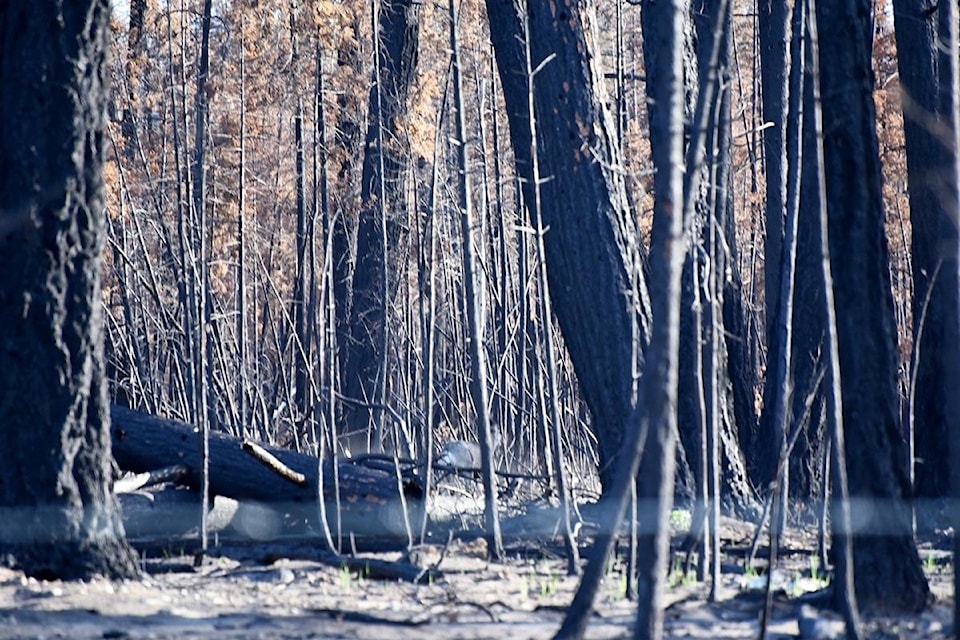Recovery from the 2017 wildfires is still taking place, and the City of Quesnel this week completed its North Cariboo Wildfire Recovery Plan for the region.
A dedicated North Cariboo Wildfire Recovery Team and Steering Committee compiled the report, which took into account 831 formal and informal in-person interviews; phone calls; and submitted surveys with businesses and non-profit organizations. The plan was funded by Emergency Management BC in order to assess the impacts of the fires and to develop recovery actions. It will be submitted to Emergency Management as well as the Ministry of Forests, Lands, Natural Resources Operation and Rural Development.
According to City of Quesnel mayor Bob Simpson, every city that had a recovery initiative was required to submit a similar report.
Social, financial and environmental recovery plans are addressed in the 38-page report, with some recovery steps already being taken and others planned for the future.
The plan identifies recovery needs including extended fuel management projects, incentives for FireSmarting; support for a communications protocol between the City of Quesnel, the Cariboo Regional District and local First Nations; forestry research and innovation to support the industry; collaboration for ecological restoration; a full-time position for emergency social services and recovery; support for businesses, non-profits, festivals, the tourism sector, as well as trappers, guide-outfitters, miners and small land-based operations; and a review of the delivery of recovery support from the Red Cross and other organizations.
The plan also has a list of nine lessons learned from the 2017 wildfires, and recommends measures for future disasters based on these lessons.
The final section outlines specific actions undertaken or needing to be undertaken in the wake of the fires. It identifies short-, medium- and long-term actions, with longer term ones to be implemented after a year or more. Many short-term actions are already listed as complete, and specific organizations or people are identified as responsible for each action. Others are listed as in progress or potential actions for the future.
“Mid and long-term recovery needs and actions are still being uncovered and realized at the time of writing this recovery plan,” the Wildfire Recovery Team writes in the plan’s conclusion.
“Communities are recovering from simultaneous events (floods and fires) while at the same time preparing for upcoming, possibly simultaneous, events. The onus is on the Provincial government to be the leaders in creating a comprehensive vision and the serious political strategies needed to achieve an unprecedented response to the unprecedented wildfire events of 2017.”
Mayor Simpson says the City has been in talks with Red Cross, United Way and the province regarding recovery.
“We have had dialogue … to look at what they are doing in the way of any longer term funding support. One of the things the report is saying, is when you have a major event … the premise is that the recovery team needs to start when you know that’s what you are dealing with, and it needs to last longer than the event. True recovery is a two to three year window, not a flash in the pan afterwards,” he explains.
Simpson says the focuses for the City right now are fuel management on crown and private lands in Quesnel’s Wildland Urban Interface (WUI), which refers to areas where homes or other burnable community structures meet with or are interspersed within wildland fuels.
“We have an approved Community Wildfire Protection Plan, so we’ve been working with funding agencies to get funding to actually do the treatments,” he says.
According to the City’s 2017 Community Wildfire Protection Plan (CWPP), which was published on the City of Quesnel website in spring this year, there is 2,700 hectares of crown land that requires fuel management treatment in and around Quesnel.
The boundaries of the project extend 2km from the fire protection boundaries of local fire departments in Bouchie Lake, 10 Mile Lake, Barlow Creek, West Fraser and Kersley. The area extends to include Dragon Mountain and Milburn Mountain, to cover communication towers.
“It’s everything from hand treatment to get rid of ladder fuels and ground fuels to full-blown salvage and logging operations,” says Simpson.
In addition, City Council last night (July 17) approved a recommendation from City staff to enter into an agreement with the Forest Enhancement Society of BC (FESBC) in order to recieve funding for fuel management.
Initially, C&C Wood Products applied for, and was awarded, a grant through FESBC for $1 million to be spend over two years to conduct forest management; however, the City and C&C agreed that transferring the grant to the City should be considered, in order for the City to complete its CWPP. The funding means the City – and therefore taxpayers – would not have to put up a percentage of the cost of the fuel treatment plans. The City is looking into additional funding options to cover the cost of the CWPP.
The City is also in talks with local private landowners regarding fuel treatments on their lands. Almost 60 per cent of Quesnel’s WUI is privately owned land.
“We have the Wildfire Branch coming up to talk to us about a new program they are putting in front of the minister in August that would provide some funding for private-land treatment as well as Crown-land treatment. We are trying to put a pilot together to get an early jump on that. Our hope is that this fall, we will begin treating the forests – crown and private – in our interface to do the preventative work that needs to be done.”
RELATED: Wildfire recovery and prevention still a hot topic for City and CRD
editor@quesnelobserver.com
Like us on Facebook and follow us on Twitter
